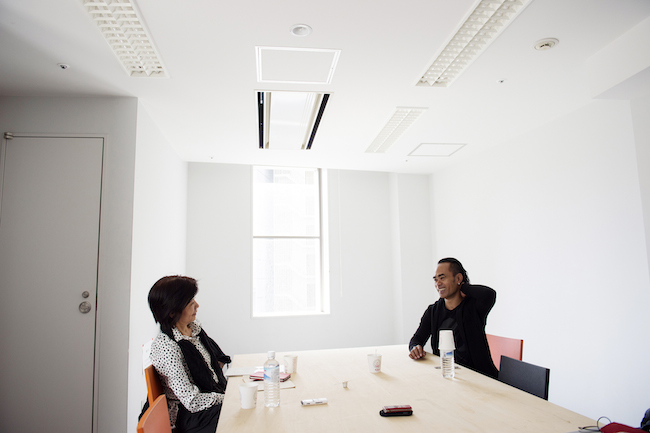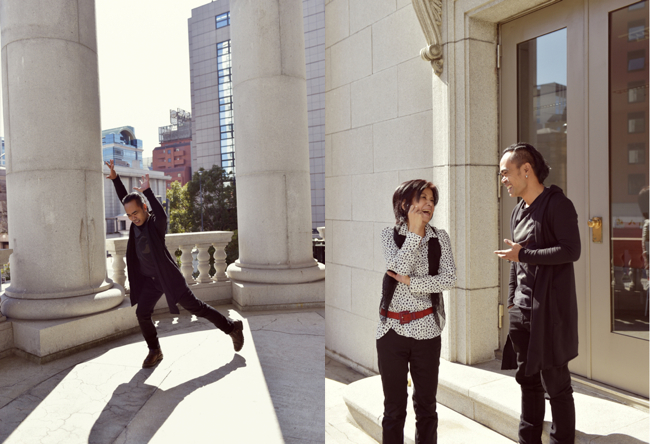Taking Advantage of Entertainment
Since coming back from the U.S., your work has widely been covering TV shows, films and entertainment events. How are these activities connected in you?
Eko: In short, I take advantage of them. I took part in Madonna's shows as a dancer, and a writer wrote a long article about me on a major newspaper in Washington. Because of that, when I came back, there were a number of TV crews at the airport, and I was treated as if I were a celebrity. I have been interviewed many times since then, and I would always say, "I am a traditional dancer from ISI Solo, and studied also at UCLA. That's why I was chosen as Madonna's dancer. If you want to become like me, working with a pop star isn't difficult, but you've got to know who you are first."
I received more offers from TV, and I would always tell them, "If you want my choreography, I don't offer my dancers as backup dancers for a pop singer, so send your dancers to Solo and let them intensively practice there." And I would declare, "If you want me to dance, this is the fee" - a considerable amount. By teaching TV dancers this way, the members of my group could own houses and cars (laughs). I work this way in films too. Recently, we have a program like So You Think You Can Dance (an American dance audition TV show) in Indonesia. When the national TV asked me to be an advisor for this show, I proposed that the program should not copy the American program but take an Indonesian approach. Therefore, the program began to invite traditional dancers from across the country. The prize money is quite good. I have been able to do this thanks to the fact that my involvement in Madonna and The Lion King made me recognized. Students come to ISI Solo, where I teach, from across the country now. There was only one class when I came back from the U.S., but now there are three. Every time I appear in the TV program, I tell the participants, "To be a dance professional is not about training and contract. It is about whether you can use your talent to make your living and support your family."
The Present of Contemporary Dance
One of the most important characteristics of Indonesian contemporary dance seems to be the fact that most of the excellent contemporary dancers have a traditional dance background. What do you think about that?
Eko: Indeed, a lot of dancers have a traditional dance background. Ery Mefri from Padang is from Minangkabau (Sumatra), Martinus Miroto and Mugiyono Kasido are from Java, and Jecko Siompo is from Papua, but they all reconsider and reinterpret their own tradition. Younger generations take a bit different approach, but it is still true that they start from their tradition. That is naturally understood because the "habitus" (conventional behaviors that have been socially obtained) comes from the environment of where you were born, and that is always traditional culture. However, what is important is not the styles or appearances but whether there is a creative statement or not. Regardless of having a traditional background or not, regardless of what your cultural identity is, you have to have your own strong and creative statement. The dancers that I mentioned are similar in that they all have a traditional background, but each of them has a unique and strong statement, so they are different.

You mentioned some important names, but including younger generations, what do you think of the current situation of Indonesian contemporary dance? Also, what do you think of education?
Eko: Sardono and I have classes in the graduate schools of the ISIs, so we visit the ISI campuses across Indonesia, and I think the situation of contemporary dance is quite good now. For instance, Solo has been producing a lot of talented young artists. Jakarta too. I visited Padang Panjang in Sumatra recently, and I met some active groups. I met some dancers in Sulawesi too. In Bali, where tradition is strong and it cannot be said that contemporary dance is active, there was expectation on Nyoman Sura, but he sadly passed away from cancer last week. But there is a student from Bali in ISI Solo now. He wants to do something, and there is something interestingly crazy in him, so Sardono and I are going to see if there is a potential in him. Since Cry Jailolo, Sardono and I have also been arguing that the schools of ISI are placed from the agricultural point of view. 80% of the territory of Indonesia is water, so we have been considering establishment of ISIs in Jailolo and Papua from an aquacultural point of view.
Is there network of contemporary dancers and choreographers?
Eko: I have also been thinking about that. I have given my links to Sal Murgiyanto. He should start something.
Sal Murgiyanto is a pioneering dancer and dance critic who advocated that "Republic of Dance" supported by four pillars - artists, critics, audience and producers - is needed to develop dance. Development of critics and audience is one of the biggest issues in Southeast Asia.
Eko: Audience need to be introduced to as many works as possible, and opportunities such as festivals have been increasing in Indonesia. But the problem is the absence of critics and writers. Sal is trying to form a group of writers and dispatch them to performances and festivals to have them write.
What do you think of the relation between contemporary dance and society?
Eko: I believe that contemporary dance has to have messages about humanity. It doesn't mean anything for me to create a simply eccentric piece. A work has to be connected to human beings, have some kind of message, and the message has to be open to interpretations. If not, it's not dance but just movements.
Pina Bausch always said, "I'm not interested in how people move but what moves them." That is exactly what I want to do. Excellent dancers can make movements, but the question is how the movements move people.
Lastly, please tell me about your next project or piece.
Eko: I want to have various dancers experience diving to explore the strange zone more. If you dive 30 meters with a heavy oxygen tank, you are like a robot and you should make minimum movements in order to stay there for a long time. If you experience it in the zero gravity, however, you find unexpected movements that you have never made. Probably the future of dance is under water (laughs).
As for my next piece, I want to work with an old woman of Jailolo with the Jailolo battle dancing I mentioned, cakalele, as the material. Cakalele used to be performed by women. I have finished my research for that, so I will stay in Jailolo in March and start choreographing. I am trying to premiere it in June 2016.

I look forward to your future activities. Thank you so much for generously taking time to talk with us.
[February 10, 2015, at Yokohama Creativecity Center]
Interviewer: Yuki Hata
Yuki Hata studied musicology at the doctoral course of Ochanomizu University, Tokyo. While on her MA at the university, she participated in the Japan Foundation's Asian performing arts exchange projects. In 1989 she joined the Foundation's newly- opened ASEAN Culture Center (later reorganized as Asia Center) as performing arts coordinator. From 2004 to 2011, she was performing arts coordinator at the Performing Arts Division at the Foundation. Through both periods, she worked on presentations of Asian contemporary performing arts in Japan, as well as international collaborations with different Asian performing artists. Currently represents Kiki Arts Project in Tokyo.






